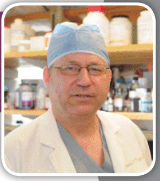
Dr. Orgill is Vice Chairman for Quality Improvement in the Department of Surgery at Brigham and Women’s Hospital and Professor of Surgery at Harvard Medical School. He is a reconstructive plastic surgeon and has a PhD from MIT in Medical Engineering. He is the Director of the Brigham and Women’s Hospital Wound Care Center and runs a tissue engineering and wound healing Laboratory. His lab at BWH is working to develop better technologies to treat wounds including work with artificial skin, micromechanical forces, platelets and stem cells. He has consulted for several medical device and start-up companies and is the inventor on several patents. He worked on the team that developed Integra®, a skin replacement therapy that has been commercially developed and used successfully on thousands of patients.
Orgill_Current Dialogues in Wound Management_2016_Volume 2_Issue 1
INTRODUCTION
The demand for wound care services continues to grow at a rapid rate due to increases in obesity and diabetes coupled with our aging population. These services can be demanding, making the team approach the natural route for many wound care programs. This is particularly true for surgeons who are well-trained in operative care and having large volumes of patients in the outpatient setting where surgery is not being performed, as this may not be the most optimal use of their skills. We, as many others have done, turned to advanced practitioners to help fill this void. The basic underlying concept is to have practitioners utilize the skills at the “top of their license.” We try to provide sufficient administrative and other basic support to allow advanced practitioners to also utilize their time efficiently.
There has been a proliferation in programs to train advanced practitioners, and many of these individuals have chosen to devote their efforts to caring for those with chronic or complex wounds.
CERTIFIED WOUND CARE NURSES
Most nurses in wound care are Certified Wound Ostomy Care (CWOC) nurses. These individuals hold a baccalaureate degree or higher and complete a formal, accredited WOC full scope or specialty education program. Admission to a program requires one year of clinical nursing experience. There are 8 WOCN educational programs in the US that applicants can consider; these now can be completed online followed by clinical rotations and a certifying exam. In addition, there are many wound certification programs not affiliated with the WOCN Organization. In our institution, CWOC nurses will generally specialize in either wound care or ostomy care even though they are trained in both. Not only do they provide direct patient care, but they are a resource for the institution in terms of education and quality improvement.
ADVANCED PRACTICE NURSES
An Advanced Practice Nurse is a registered nurse who has completed an advanced, graduate level education program and has passed a national certification examination in order to practice in one of four APN roles: Clinical Specialist, Nurse Midwife, Nurse Practitioner and Nurse Anesthetist. The most commonly used certifications in wound care are Nurse Practitioners and Clinical Specialists. They can both assess and treat medical conditions and have a focus on disease prevention and health management. Philosophically, they have a patient-centered approach to health care. They are licensed by state and their scope of practice is governed by the individual state where they practice. In many states they can diagnose, treat medical conditions and write prescriptions. In many locations, they are able to practice independently of a physician. In our institution, we have Nurse Practitioners in our Inpatient Plastic Surgery Service, and they perform all surgical pre-operative anesthesia evaluations.
PHYSICIAN ASSISTANTS
Physician Assistants typically undergo a two-year Masters Degree program after completing a Bachelors degree and approximately one year of hands-on patient care experience. They’re certified after taking a national exam. Some now do one or more years of a PA fellowship. Following initial certification, they are required to have 100 hours of CME every 2 years and pass a recertification exam every 10 years. They are licensed by state, and their scope of practice is governed by the individual state in which they practice. In most states they can diagnose, treat medical conditions and write prescriptions. Philosophically, they practice a disease-focused model and function under the direct supervision of a physician. In our institution, we have Physician Assistants in the outpatient Wound Care Center, Plastic Surgery Clinic, Inpatient Plastic Surgery Service and Inpatient Wound Consult Service.
FROM A PHYSICIAN PERSPECTIVE – OUR EXPERIENCE
Our experience has shown that all three of these advanced practitioners can be extremely helpful in the area of wound healing. Nationally, the WOC certification has been long recognized as certifying knowledge in wound healing and ostomy care. In our Wound Care Center we have one CWOC nurse who has developed an expertise in dressings and compression for our patients with venous stasis ulcerations. She will see patients who need dressing changes independently, with a licensed independent practitioner’s (LIP) order and will seek the advice of others when needed. The entire team seeks her advice when there is a question on specific dressings.
Our inpatient WOC nurses focus mainly on ostomy care but provide support to the nursing service for many smaller wounds and skin/continence issues. We have two Physician Assistants that work in our Wound Care Center. They see all patients, document visits and create and monitor wound management plans. They participate in seeing inpatient wound consults and travel to local rehabilitation facilities to see patients with wound issues. Having a member of our team available in the inpatient, rehabilitation and outpatient setting allows our patients to have continuity of care across disparate care settings. Our physicians will see all new patients and follow-up with patients as needed. Our physician assistants will do minor procedures in the outpatient OR and assist surgeons in the main operating room for larger procedures. They help run clinical trials, write papers and present at local, national and international meetings. They organize a bi-annual meeting on wound care we put on for regional practitioners and give frequent talks to medical residents, nurses and others.
CONCLUSION
In our institution, we use all of the different types of licensed advanced practitioners currently available for different facets of wound care. In our patient satisfaction studies, we have had wonderful reviews of these individuals, including a very positive impact on our patient care. The scope of practice will vary by location as it is defined by each state. Also, there are specific local rules within a hospital that must be adhered to. In conclusion, we believe the strategic use of advanced practitioners is a nice way to optimize the patient’s experience and allow busy surgeons to continue to participate in the growing and increasingly demanding field of wound care.
References
Become a WOC Nurse. Wound, Ostomy and Continence Nurses Society™ (WOCN®). Available at http://www.wocn.org/?become_a_woc_nurse. Accessed December 28, 2015.


